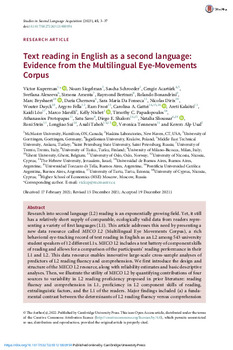| dc.rights.license | https://creativecommons.org/licenses/by-sa/2.5/ar/ | es_AR |
| dc.contributor.author | Gattei, Carolina A. | es_AR |
| dc.contributor.author | Taboh, Analí R. | es_AR |
| dc.contributor.author | et al. | es_AR |
| dc.date.accessioned | 2023-05-31T19:44:15Z | |
| dc.date.available | 2023-05-31T19:44:15Z | |
| dc.date.issued | 2023 | |
| dc.identifier.uri | https://repositorio.utdt.edu/handle/20.500.13098/11852 | |
| dc.identifier.uri | https://doi.org/10.1017/S0272263121000954 | |
| dc.description.abstract | Research into second language (L2) reading is an exponentially growing field. Yet, it still
has a relatively short supply of comparable, ecologically valid data from readers representing
a variety of first languages (L1). This article addresses this need by presenting a
new data resource called MECO L2 (Multilingual Eye Movements Corpus), a rich
behavioral eye-tracking record of text reading in English as an L2 among 543 university
student speakers of 12 different L1s.MECO L2 includes a test battery of component skills
of reading and allows for a comparison of the participants’ reading performance in their
L1 and L2. This data resource enables innovative large-scale cross-sample analyses of
predictors of L2 reading fluency and comprehension. We first introduce the design and
structure of the MECO L2 resource, along with reliability estimates and basic descriptive
analyses. Then, we illustrate the utility of MECO L2 by quantifying contributions of four
sources to variability in L2 reading proficiency proposed in prior literature: reading
fluency and comprehension in L1, proficiency in L2 component skills of reading,
extralinguistic factors, and the L1 of the readers. Major findings included (a) a fundamental
contrast between the determinants of L2 reading fluency versus comprehension accuracy, and (b) high within-participant consistency in the real-time strategy of reading
in L1 and L2.We conclude by reviewing the implications of these findings to theories of L2
acquisition and outline further directions in which the new data resourcemay support L2
reading research. | es_AR |
| dc.description.sponsorship | Este artículo se encuentra publicado en Studies in Second Language Acquisition, 45(1), 3-37. | es_AR |
| dc.format.extent | pp. 3-37 | es_AR |
| dc.format.medium | application/pdf | es_AR |
| dc.language | eng | es_AR |
| dc.publisher | Studies in Second Language Acquisition | es_AR |
| dc.publisher | Cambridge University Press | es_AR |
| dc.relation.ispartof | Studies in Second Language Acquisition (2023), 45, 3–37 | |
| dc.rights | info:eu-repo/semantics/openAccess | es_AR |
| dc.subject | Second language reading | es_AR |
| dc.subject | Reading comprehension | es_AR |
| dc.subject | Reading performance | es_AR |
| dc.subject | Contributions to variability in second language reading proficiency | es_AR |
| dc.subject | Real-time strategy of reading | es_AR |
| dc.subject | Multilingual Eye-Movements Corpus | es_AR |
| dc.title | Text reading in English as a second language: Evidence from the Multilingual Eye-Movements Corpus | es_AR |
| dc.type | info:eu-repo/semantics/article | es_AR |
| dc.type.version | info:eu-repo/semantics/publishedVersion | es_AR |

